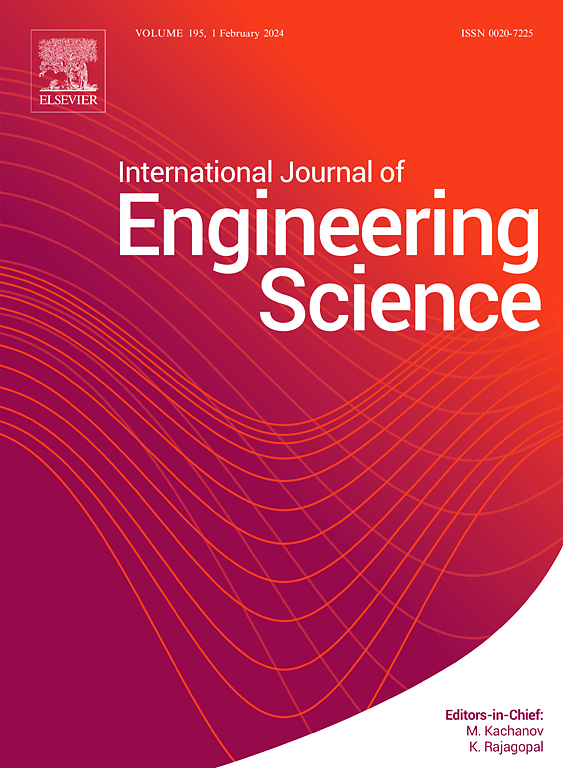具有一般不完美界面的多晶固体的有效弹性刚度
IF 5.7
1区 工程技术
Q1 ENGINEERING, MULTIDISCIPLINARY
International Journal of Engineering Science
Pub Date : 2025-03-25
DOI:10.1016/j.ijengsci.2025.104259
引用次数: 0
摘要
建立了具有各向同性晶粒和一般不完美界面的多晶固体的分析自一致模型。晶粒-晶粒结合条件假定在界面上位移矢量和法向牵引矢量都有跳跃。该模型与具有纳米级微观结构的固体中弯曲变形界面的一般理论(Gurtin et al., 1998)一致,证明其适用于弹性纳米多晶。讨论了多晶不完美界面自洽微观力学模型的正确表述。通过对零偶极矩条件下有效介质中不完全键合非均匀性模型问题的多极展开解,导出了有效弹性模量的显式公式。将所建立的理论和数值结果与已有的弹簧型和膜型界面结果进行了比较,验证了理论和数值结果的正确性。本文章由计算机程序翻译,如有差异,请以英文原文为准。
Effective elastic stiffness of polycrystalline solid with general imperfect interface
The analytical self-consistent model of a polycrystalline solid with isotropic grains and a general imperfect interface has been developed. The grain-to-grain bonding conditions assume a jump of both the displacement and normal traction vectors across the interface. The model is consistent with the general theory of curved deformable interfaces in solids with nanometre-scale microstructure (Gurtin et al., 1998) that justifies its applicability to the elastic nanopolycrystals. The proper formulation of the self-consistent micromechanical model of polycrystal imperfect interface is discussed. The explicit formulas for the effective elastic moduli are derived from the multipole expansion solution to the model problem under the zero dipole moment condition of the imperfectly bonded inhomogeneity in the effective medium. The developed theory and numerical results are validated by comparison with the available results for the spring and membrane-type interfaces.
求助全文
通过发布文献求助,成功后即可免费获取论文全文。
去求助
来源期刊

International Journal of Engineering Science
工程技术-工程:综合
CiteScore
11.80
自引率
16.70%
发文量
86
审稿时长
45 days
期刊介绍:
The International Journal of Engineering Science is not limited to a specific aspect of science and engineering but is instead devoted to a wide range of subfields in the engineering sciences. While it encourages a broad spectrum of contribution in the engineering sciences, its core interest lies in issues concerning material modeling and response. Articles of interdisciplinary nature are particularly welcome.
The primary goal of the new editors is to maintain high quality of publications. There will be a commitment to expediting the time taken for the publication of the papers. The articles that are sent for reviews will have names of the authors deleted with a view towards enhancing the objectivity and fairness of the review process.
Articles that are devoted to the purely mathematical aspects without a discussion of the physical implications of the results or the consideration of specific examples are discouraged. Articles concerning material science should not be limited merely to a description and recording of observations but should contain theoretical or quantitative discussion of the results.
 求助内容:
求助内容: 应助结果提醒方式:
应助结果提醒方式:


